SONS OF DEWITT COLONY TEXAS
© 1997-2012, Wallace L. McKeehan, All Rights Reserved.
DeWitt Colony Flags 1700-1846
(See also Flags of Independence 1835-1836)
For More Description and Biographies, Search
Handbook of Texas Online
Flags of
New Spain
 Castile and Leon. Most commonly shown as the flag displayed in New Spain and in Spanish Texas, this banner represented the combined
kingdoms of Castile (the
castle) and Leon (the lions). Variants using the two symbols were flown by Spanish
explorers of the New World including Columbus. (Adapted from C. E. Gilbert Jr. A
Concise History of Early Texas: As told by its 30 historic flags.) Castile and Leon. Most commonly shown as the flag displayed in New Spain and in Spanish Texas, this banner represented the combined
kingdoms of Castile (the
castle) and Leon (the lions). Variants using the two symbols were flown by Spanish
explorers of the New World including Columbus. (Adapted from C. E. Gilbert Jr. A
Concise History of Early Texas: As told by its 30 historic flags.)
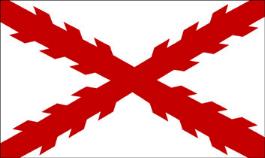 The Cross of Burgundy was adopted in about 1520. It was a symbol of Phillip I, Duke of Burgundy, whose
son became King Charles I of Spain in 1516. The Cross of Burgundy and variants was
probably the most common banner displayed on land and sea in New Spain, particularly by
the Spanish military. The Cross of Burgundy was adopted in about 1520. It was a symbol of Phillip I, Duke of Burgundy, whose
son became King Charles I of Spain in 1516. The Cross of Burgundy and variants was
probably the most common banner displayed on land and sea in New Spain, particularly by
the Spanish military.
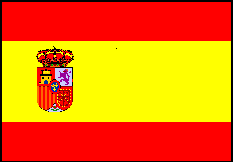 The Spanish Flag of 1785 and
its variants may also have been flown in Spanish Texas. The banner and its variants
employed variations of a shield with the symbols of Castile and Leon and other historic
royal alliances topped with a crown in the yellow field of the red-yellow-red tricolor. The Spanish Flag of 1785 and
its variants may also have been flown in Spanish Texas. The banner and its variants
employed variations of a shield with the symbols of Castile and Leon and other historic
royal alliances topped with a crown in the yellow field of the red-yellow-red tricolor.
The First
Independent State of Texas
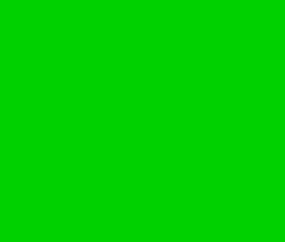 In the fall of 1812, the Republican Army of the North comprised of both
revolutionaries from south of the Rio Grande and east of the Sabine River under Col.
Bernardo Gutierrez de Lara and Col. Augustus Magee gained control of Texas from the Sabine
River to the Guadalupe River which included part of future DeWitt Colony and declared the
province an independent State of Texas, part of the Republic of Mexico before the
independence of Mexico was solidified. As First President of an independent Texas,
Gutierrez established the first Constitution of Texas in
1813, but his movement was clouded by the brutal execution of captured Royalist Texas Gov.
Salcedo and several of his officers. He was deposed by Col. Alverez de Toledo who renamed
the movement the Republican Army of North Mexico and was soundly defeated by Spanish
royalists at the Battle of Medina in fall 1813. This solid emerald green flag was thought
to have been introduced by Bostonite and former US Army Lieutenant Augustus Magee who was
of Irish background. In the fall of 1812, the Republican Army of the North comprised of both
revolutionaries from south of the Rio Grande and east of the Sabine River under Col.
Bernardo Gutierrez de Lara and Col. Augustus Magee gained control of Texas from the Sabine
River to the Guadalupe River which included part of future DeWitt Colony and declared the
province an independent State of Texas, part of the Republic of Mexico before the
independence of Mexico was solidified. As First President of an independent Texas,
Gutierrez established the first Constitution of Texas in
1813, but his movement was clouded by the brutal execution of captured Royalist Texas Gov.
Salcedo and several of his officers. He was deposed by Col. Alverez de Toledo who renamed
the movement the Republican Army of North Mexico and was soundly defeated by Spanish
royalists at the Battle of Medina in fall 1813. This solid emerald green flag was thought
to have been introduced by Bostonite and former US Army Lieutenant Augustus Magee who was
of Irish background.
Republic of
Mexico
 The first flag of independent Mexico of which the province of Texas was a part,
was La Bandera de las Tres Garantias, a white, green
and red tri-color with a gold star in each field. This Flag of the United Mexican States
adopted in 1825 under the liberal Constitution of 1824
consisting of vertical green, white and red fields is still in use today. The first flag of independent Mexico of which the province of Texas was a part,
was La Bandera de las Tres Garantias, a white, green
and red tri-color with a gold star in each field. This Flag of the United Mexican States
adopted in 1825 under the liberal Constitution of 1824
consisting of vertical green, white and red fields is still in use today.
It consists of an eagle perched on a cactus with a snake
in its mouse and talons. According to legend, the Aztec God of War
Huitzilopochtli instructed ancient peoples to build an empire where they found the eagle
and snake. After years of wandering about, on an island in Lake Texcoco in the
Valley of Mexico (Anahuac) they found the sign and there in 1325 AD built the city of
Tenochtitlan ("Place of the Prickly Pear Cactus"), now Mexico City. The
eagle rests on a fruiting nopal cactus, the red "tunas" a symbol of the human
heart in Aztec legend. Under the cactus are republican symbols, scrolls and codices
and lower down garlands tied together with a ribbon of three colors, symbolic of both pre-
and post-Hispanic Mexico.
Coahuila
y Tejas
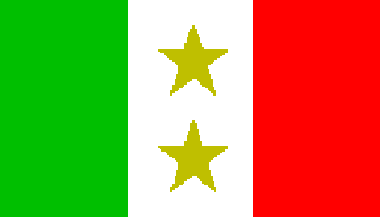 DeWitt Colonists lived under the State Flag of Coahuila y Tejas in the
1820’s and 1830’s. The two stars signified the two regions that comprised the State of Coahuila and Texas. Col.
Juan Almonte, aid to Santa Anna, states "the enemy, as soon as
the march of the division was seen, hoisted the tri-colored flag with two stars, designed
to represent Coahuila and Texas" in his journal entry about the Siege and Battle
of the Alamo. Mexican officer and engineer Carlos Sanchez-Navarro, who participated in the
siege of the Alamo in Mar 1836 in his memoirs, La Guerra de Tejas, Memorias de un
Soldado, shows in a illustration the flag of Coahuila y Tejas flying over the Alamo.
It has also been speculated that this banner may have been carried by Capt. Juan Seguin's
company at the Battle of Bexar and taken with them to the Alamo garrison. A
1934 article in the San Antonio Express suggests that some historians believed that the
stars were blue: "Kennedy, Texas II, 180-181, says that the flag used by
Texas was the Mexican tricolor, red, white and green, with two blue stars in the white
bar, Bancroft and others agree with Kennedy that this was the Coahuila-Texas flag." DeWitt Colonists lived under the State Flag of Coahuila y Tejas in the
1820’s and 1830’s. The two stars signified the two regions that comprised the State of Coahuila and Texas. Col.
Juan Almonte, aid to Santa Anna, states "the enemy, as soon as
the march of the division was seen, hoisted the tri-colored flag with two stars, designed
to represent Coahuila and Texas" in his journal entry about the Siege and Battle
of the Alamo. Mexican officer and engineer Carlos Sanchez-Navarro, who participated in the
siege of the Alamo in Mar 1836 in his memoirs, La Guerra de Tejas, Memorias de un
Soldado, shows in a illustration the flag of Coahuila y Tejas flying over the Alamo.
It has also been speculated that this banner may have been carried by Capt. Juan Seguin's
company at the Battle of Bexar and taken with them to the Alamo garrison. A
1934 article in the San Antonio Express suggests that some historians believed that the
stars were blue: "Kennedy, Texas II, 180-181, says that the flag used by
Texas was the Mexican tricolor, red, white and green, with two blue stars in the white
bar, Bancroft and others agree with Kennedy that this was the Coahuila-Texas flag."
Constitution
of 1824
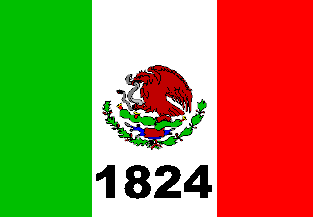 The Mexican tricolor with modifications to symbolize support
of the Federalist system guaranteed by the Constitution of the
Mexican United States of 1824 remained the official banner sanctioned by a government
of Texas, official, provisional or otherwise. No other flag was officially sanctioned
until the naval flag adopted by President Burnet on 9 Apr 1836
just before the battle of San Jacinto on 21 Apr. These banners indicate an evolution from
the tricolor of the Republic of Mexico to addition of the words 1824
to removal of the Mexican eagle and snake as sympathy for independence and separation from
the central government of Mexico intensified. A banner employing the Mexican tricolors
with reference to the Constitution of 1824 was thought to be preferred by a majority of
DeWitt Colonists as their official flag in late 1835 and into early 1836 although almost
all supported independence as a Mexican State and then a sovereign Republic as they
prepared for war with the centralista government. The Mexican tricolor with modifications to symbolize support
of the Federalist system guaranteed by the Constitution of the
Mexican United States of 1824 remained the official banner sanctioned by a government
of Texas, official, provisional or otherwise. No other flag was officially sanctioned
until the naval flag adopted by President Burnet on 9 Apr 1836
just before the battle of San Jacinto on 21 Apr. These banners indicate an evolution from
the tricolor of the Republic of Mexico to addition of the words 1824
to removal of the Mexican eagle and snake as sympathy for independence and separation from
the central government of Mexico intensified. A banner employing the Mexican tricolors
with reference to the Constitution of 1824 was thought to be preferred by a majority of
DeWitt Colonists as their official flag in late 1835 and into early 1836 although almost
all supported independence as a Mexican State and then a sovereign Republic as they
prepared for war with the centralista government.
The design below (top) was that described by Capt.
Phillip Dimmit, Commander at Goliad in a letter to Stephen F. Austin of 27 Oct 1835: "I
have had a flag made---the colors and their arrangement the same as the old one---with the
words and figures, 'Constitution of 1824', displayed on the white in the
center." Although the provisional government of Texas never adopted an official
banner, it sanctioned a privateer flag of marque and reprisal for those who would prey
upon "centralista" shipping in the Gulf of Mexico: "That all vessels
sailing under Licences, as Letters of Marque and Reprisal...shall carry the flag of the
Republic of the United States of Mexico, and shall have the figures 1,8,2,4 cyphered in
large Arabics on the white ground thereof" (bottom right). According to multiple
Texas historians including Amelia Williams and John Henry Brown, the Mexican tri-color
shown below with the numerals 1824 on the white bar flew over the Alamo during the siege
of Mar 1835. Variants on the theme may have been to employ different colors for the
lettering on the white background as well as size and orientation (horizontal and
vertical) (see 1824 Flag of the Texas
Revolution).
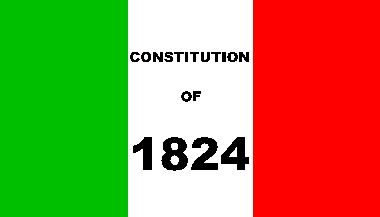
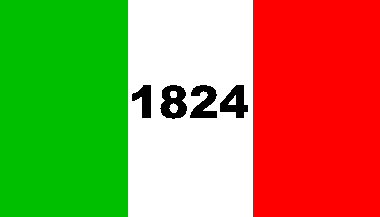
A little known employment of the Mexican
Eagle on a pure white background was in a naval signal flag used by pilots at the mouth of
Texas rivers as described by pilot J. Brown in 1835:
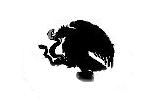 Notice To Ship Masters. The undersigned takes
this method of informing the public that another flagstaff has been erected at the mouth
of the Brazos and as the bar is very often too rough for boats to board vessels, they
might be deceived by seeing both flags flying and in range together therefore the
following signals will be exhibited: Notice To Ship Masters. The undersigned takes
this method of informing the public that another flagstaff has been erected at the mouth
of the Brazos and as the bar is very often too rough for boats to board vessels, they
might be deceived by seeing both flags flying and in range together therefore the
following signals will be exhibited:
At high water will be hoisted at the flagstaff a white
flag with a Mexican Eagle, in black in the middle. If it is half tide or low water the
sarne will be hoisted at half mast only-should she not be boarded and there be plenty of
water on the Bar the following rules may be observed:
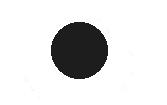 When the vessle is
near down to the Bar the flag on the flagstaff will be hauled down and two smaller flags
erected at a suitable distance from each other these flags will be a black Ball on a white
ground-and are the ranges for crossing the Bar without a Pilot. In running down should it
be to rough for boats to come out you should lay off and on, taking care not to get to the
Westward of the Bar as there is generally a strong current setting in that direction, and
unless your vessel sails well It will be almost impossible to come in. Vessels with good
ground tackle need not be afraid to anchor off the Bar taking care to anchor in 4 1/2
fathoms water in rough weather, and in fine weather they can anchor in safety 3 1/2
fathoms. When vessels are off the Bar in bad weather, a fire will be made on the Beach
every night. I shall still continue to conduct the Pilotage as usual and so do my duty at
the hazard of my life. J. Brown, Pilot. Mouth of Rio Brazos, May 23rd 1835. When the vessle is
near down to the Bar the flag on the flagstaff will be hauled down and two smaller flags
erected at a suitable distance from each other these flags will be a black Ball on a white
ground-and are the ranges for crossing the Bar without a Pilot. In running down should it
be to rough for boats to come out you should lay off and on, taking care not to get to the
Westward of the Bar as there is generally a strong current setting in that direction, and
unless your vessel sails well It will be almost impossible to come in. Vessels with good
ground tackle need not be afraid to anchor off the Bar taking care to anchor in 4 1/2
fathoms water in rough weather, and in fine weather they can anchor in safety 3 1/2
fathoms. When vessels are off the Bar in bad weather, a fire will be made on the Beach
every night. I shall still continue to conduct the Pilotage as usual and so do my duty at
the hazard of my life. J. Brown, Pilot. Mouth of Rio Brazos, May 23rd 1835.
Old
Come and Take It
 Of the multiple banners that flew over DeWitt
Colony territory and those under which DeWitt colonists served and died, this famous flag
is one which originated solely within and is unique to the DeWitt Colony and a symbol of
contribution of the region to the Texas Independence movement. The banner can be said to
be the counterpart in concept and message of resistance as the early "Don't Tread on Me" flags of
the American Revolution. Some say it was made from the white silk of the wedding dress of Empresario DeWitt's daughter, Naomi, and was flown
by DeWitt Colonists reinforced by volunteers from the other settlements at the
confrontation with the Mexican army in October 1835 over the Gonzales cannon (Battle of Gonzales). Other reports suggest it was made after the
confrontation during the muster at Gonzales for defense of Texas and the assault on Bexar. Of the multiple banners that flew over DeWitt
Colony territory and those under which DeWitt colonists served and died, this famous flag
is one which originated solely within and is unique to the DeWitt Colony and a symbol of
contribution of the region to the Texas Independence movement. The banner can be said to
be the counterpart in concept and message of resistance as the early "Don't Tread on Me" flags of
the American Revolution. Some say it was made from the white silk of the wedding dress of Empresario DeWitt's daughter, Naomi, and was flown
by DeWitt Colonists reinforced by volunteers from the other settlements at the
confrontation with the Mexican army in October 1835 over the Gonzales cannon (Battle of Gonzales). Other reports suggest it was made after the
confrontation during the muster at Gonzales for defense of Texas and the assault on Bexar.
Eyewitness DeWitt Colonist Creed Taylor relates in his
memoirs (Tall Men with Long Rifles) that following the Battle of Gonzales as the
army was being prepared in Gonzales to march on Bexar "the question of a flag
came up. Some of our leaders wanted to march and fight under the Mexican national colors;
others wanted the eagle, cactus, and snake, eliminated from the flag and in their stead a
star. But it was soon ascertained that the boys wanted nothing that bore the slightest
resemblance to the flag of Mexico. At a meeting of the officers a committee of five were
appointed to select the design for our flag. This committee was to report by three o'clock
the next day. And this gave the occasion for the loftiest display of patriotism on the
part of the women of Gonzales. They knew that material for a flag was scarce. Before ten
o'clock the committee in council was overwhelmed with offers of material of all shades,
textures, and fashions. A few silk dresses that had doubtless been worn on state occasions
'back in the states' and were now faded and tattered---but religiously treasured as sacred
mementoes of happier days---were brought forward and freely offered. One heroic mother
whose sons went down in the Alamo the following March, brought her only pair of green
window curtains. It was finally decided by the committee that it was the duty of the
Consultation to design and adopt a flag of the new nation; that any action in regard
thereto would be premature and not binding; but in view of the present conditions it would
be right and proper for the army to have a banner under which to march during the present
campaign, and that in keeping with the simplicity that characterized the general make-up
of the army the said emblem be as follows: a white field without border, in the center a
picture of a cannon, unmounted and without any fixtures whatever, directly over the cannon
a five pointed star. Under the cannon and near the lower margin in large letters extending
nearly the length of the flag, this inscription: 'COME AND TAKE IT.' The
flag committee's report was received and its recommendations accepted, and the following
day we had a flag raising, when, for the first time, the Lone Star was flung to the
breeze........I must bear witness to the fact that the 'cannon flag' designed and hoisted
at Gonzales on October 10, 1835, was the first Lone Star that was ever caressed by a Texas
breeze unless the honor should be given to the Dawson
[Dodson] Company standard......never recognized by the army as their flag, but a
company standard......our 'Cannon Flag' had been left somewhere on the route from Gonzales
to Salado. The last I saw of it was when the cannon was abandoned on Sandy Creek. It had
been furled and was resting against a sapling nearby. It may have been used as a winding
sheet for the old brass gun or it may have been employed for baser purposes."
The Lone
Star
"....bear witness to the fact that the 'cannon flag' designed and hoisted [by the first Texian army] at
Gonzales on October 10, 1835, was the first Lone Star that was ever caressed by a Texas
breeze unless the honor should be given to the Dawson
[Dodson] Company standard..."--Creed Taylor
'....the buttons on the coat of Governor Smith had the impress of a
five-pointed star. For want of a seal, one of the buttons was cut off and used."--Guy
M. Bryan
 Despite DeWitt Colonist Creed Taylor's
regional pride expressed in his memoirs concerning the Old Come and
Take It flag (Creed's father, Josiah Taylor, was with the Gutierrez-Magee Expedition against Spain in 1813,
who some refer to as the first Republic of Texas), the first Lone Star on record in Texas
was employed on the Long flag of
independence filibuster Dr. James Long in 1819 while Texas was still a province of New
Spain. Despite DeWitt Colonist Creed Taylor's
regional pride expressed in his memoirs concerning the Old Come and
Take It flag (Creed's father, Josiah Taylor, was with the Gutierrez-Magee Expedition against Spain in 1813,
who some refer to as the first Republic of Texas), the first Lone Star on record in Texas
was employed on the Long flag of
independence filibuster Dr. James Long in 1819 while Texas was still a province of New
Spain.
 The state flag of Coahuila y Texas
employed five-pointed stars on the white of the Mexican tricolor and the Lone Star may
have been adopted to signify the desired independence of the Mexican state of Texas from
Coahuila. Various flags of Texas independence movements, Scott's flag of the
liberal faction, Baker's flag
of San Felipe, flag of the Harriburg
Volunteers and the Troutman
flag at Goliad all employed the Lone Star. The state flag of Coahuila y Texas
employed five-pointed stars on the white of the Mexican tricolor and the Lone Star may
have been adopted to signify the desired independence of the Mexican state of Texas from
Coahuila. Various flags of Texas independence movements, Scott's flag of the
liberal faction, Baker's flag
of San Felipe, flag of the Harriburg
Volunteers and the Troutman
flag at Goliad all employed the Lone Star.
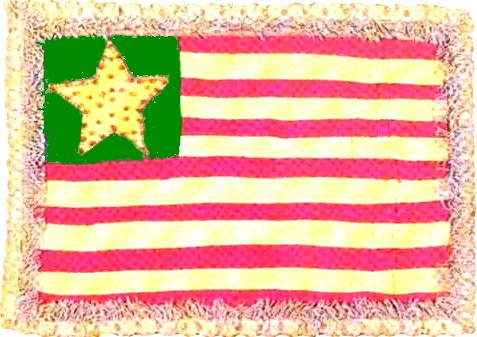 Burnet Naval Flag.
The first official national flag sanctioned by the provisional government appears to be
that adopted by President Burnet at Harrisburg, 9 Apr 1836 for the naval service. The flag
was approved at Columbia 10 Dec 1836 and was in use as a naval flag as late as 1839. The
only known surviving flag, actual or replica (photo left), of the period is from
the 1840's scrapbook of Julia Lee Sinks, wife of Austin postmaster George W. Sinks. It is
noteworthy that in the Sink's replica the lone star was sewn in gold (similar to a star
from the flag of Coahuila y Tejas above and the Burnet flag of
the Republic below) in an upper left field of Mexican green rather than blue. In later
histories the flag is depicted as the US flag with a single star in the upper left blue
field which was described by Guy M. Bryan in a speech to the Texas Veterans Association
1873 "union blue, star central, and thirteen stripes, alternate red and
white." Burnet Naval Flag.
The first official national flag sanctioned by the provisional government appears to be
that adopted by President Burnet at Harrisburg, 9 Apr 1836 for the naval service. The flag
was approved at Columbia 10 Dec 1836 and was in use as a naval flag as late as 1839. The
only known surviving flag, actual or replica (photo left), of the period is from
the 1840's scrapbook of Julia Lee Sinks, wife of Austin postmaster George W. Sinks. It is
noteworthy that in the Sink's replica the lone star was sewn in gold (similar to a star
from the flag of Coahuila y Tejas above and the Burnet flag of
the Republic below) in an upper left field of Mexican green rather than blue. In later
histories the flag is depicted as the US flag with a single star in the upper left blue
field which was described by Guy M. Bryan in a speech to the Texas Veterans Association
1873 "union blue, star central, and thirteen stripes, alternate red and
white."
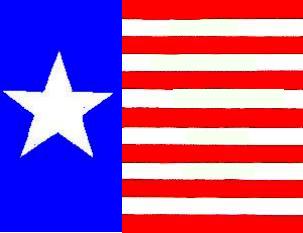 If blue was the
true color it was probably adapted from the Lone Star on blue of Scott's flag of the
Liberal Faction or War Party with the 13 red and white stripes of the US flag. Instead of
the rendition at left, it may have been simply the US flag with a single star in the blue
field in the upper left corner with stripes across the entire bottom as in the Sink's
replica above. It was thought to have been made by ladies at Harrisburg at the home of
Mrs. Jane Harris with whom David Burnet resided at the time. The naval flag was thought to
have been designed quickly by Burnet in response to the need to establish identity and
elements of a functioning government after San Jacinto. Some say it was intentional to
imply sanction and protection of Texian ships by flying the US banner or something closely
similar. If blue was the
true color it was probably adapted from the Lone Star on blue of Scott's flag of the
Liberal Faction or War Party with the 13 red and white stripes of the US flag. Instead of
the rendition at left, it may have been simply the US flag with a single star in the blue
field in the upper left corner with stripes across the entire bottom as in the Sink's
replica above. It was thought to have been made by ladies at Harrisburg at the home of
Mrs. Jane Harris with whom David Burnet resided at the time. The naval flag was thought to
have been designed quickly by Burnet in response to the need to establish identity and
elements of a functioning government after San Jacinto. Some say it was intentional to
imply sanction and protection of Texian ships by flying the US banner or something closely
similar.
Some records indicate a flag exhibiting the Lone Star on
a horizontal field of blue between single upper white and lower red horizontal stripes
running the full length of the flag was either proposed or used at one time in the
Republic of Texas.
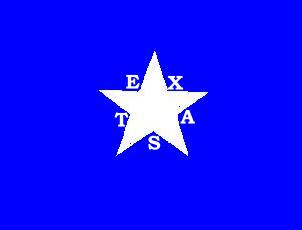 The
Zavala Flag. Proceedings of the Texas Independence Convention of 11
Mar 1836: "On the motion of Mr. Scates, the Rainbow and star of five points
above the western horizon; and the star of six points sinking below, was added to the flag
of Mr. Zavala accepted on Friday last. Mr. Taylor introduced the following
resolution: Resolved that the word "Texas" be placed, one letter between
each point of the star on the national flag." The banner at left is most often
depicted as the first official flag of the Texas Republic proposed by Vice-President of
the new Republic of Texas, Lorenzo de Zavala. The proceedings appear to indicate
that Zavala proposed a simple Lone Star flag which if white on blue was essentially that
of Scott's flag of
the War Party without the word "Independence," or the left part of
Burnet's naval flag. It is unclear whether any of the proposed modifications
including the indicated lettering were ever employed. The
Zavala Flag. Proceedings of the Texas Independence Convention of 11
Mar 1836: "On the motion of Mr. Scates, the Rainbow and star of five points
above the western horizon; and the star of six points sinking below, was added to the flag
of Mr. Zavala accepted on Friday last. Mr. Taylor introduced the following
resolution: Resolved that the word "Texas" be placed, one letter between
each point of the star on the national flag." The banner at left is most often
depicted as the first official flag of the Texas Republic proposed by Vice-President of
the new Republic of Texas, Lorenzo de Zavala. The proceedings appear to indicate
that Zavala proposed a simple Lone Star flag which if white on blue was essentially that
of Scott's flag of
the War Party without the word "Independence," or the left part of
Burnet's naval flag. It is unclear whether any of the proposed modifications
including the indicated lettering were ever employed.
A banner was described which would be essentially the
Burnet naval flag with a white Lone Star on blue in Davy Crockett's putative
autobiography, Life of David Crockett, "we have had a large national
flag made; it is composed of thirteen stripes, red and white, alternately, on a blue
ground with a large white star, of five points, in the center, and between the points the
letters TEXAS....we set about raising our flag on the battlements [of the Alamo]."
Proceedings of the Independence Convention at Washington
on the Brazos, 12 Mar 1836 stated: Mr. Childress introduced the following
resolution: "Resolved that a single star of five points, either of gold or
silver, be adopted as the peculiar emblem of this republic; & that every officer &
soldier of the army and members of this convention, and all friends of Texas, be requested
to wear it on their hats or bosoms; which was adopted."
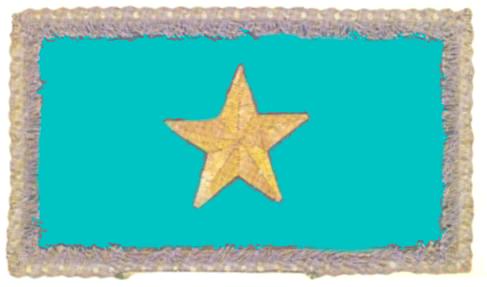 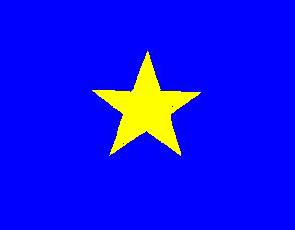
|
The Burnet Lone Star Flag.
The Julia Lee Sinks scrapbook also contains a replica of the "first official flag of
the Republic," proposed by President David G. Burnet at the meeting of the First
Congress of the Republic held in Columbia, 10 Dec 1836 when the Burnet
naval flag was also adopted. Like the Burnet naval flag, this is the only known
survivor of the period. Although the flag is depicted in most histories as a gold star in
a bright solid blue field, the star in Sink's flag was gold in a field of bluish-green or
marine, similar to the upper left field in the Sink's replica of the Burnet naval flag. A
simplification of the Zavala flag, the Burnet Lone Star flag,
sometimes referred to as the second official flag of the Texas Republic, was essentially
the left part of the Burnet naval flag with a gold star and the Zavala flag with the white
star colored gold without the lettering around the star. |
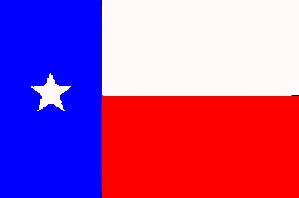 The Lone Star.
The current Lone Star flag of first the Republic and then the State of Texas was proposed
by William H. Wharton 27 Dec 1838 at the Third Congress of the Republic in Houston and
approved 25 Jan 1839. Historically, the flag is said to have been designed by Dr. Charles
B. Stewart with concensus by a flag committee chaired by Oliver Jones of seven signers:
Thomas Barnett, Richard Ellis, Thomas J. Gazley, Sterling C.
Robertson, William B. Scates and Lorenzo de Zavala.
Others contend the actual designer and group who approved it is unclear. Archival sketches show the current Lone
Star flag and Texas State Seal drawn by Peter Krag. It is thought that an improvised
seal used provided by Dr. Stewart for the official mark on a treaty between the
provisional Texas government and the Cherokees may have influenced design of the
Lone Star banner and seal. On 28 December 1835, it is said the Cherokees
demanded a seal or official marking. Dr. Stewart was secretary to provisional
governor Henry Smith and related: The Lone Star.
The current Lone Star flag of first the Republic and then the State of Texas was proposed
by William H. Wharton 27 Dec 1838 at the Third Congress of the Republic in Houston and
approved 25 Jan 1839. Historically, the flag is said to have been designed by Dr. Charles
B. Stewart with concensus by a flag committee chaired by Oliver Jones of seven signers:
Thomas Barnett, Richard Ellis, Thomas J. Gazley, Sterling C.
Robertson, William B. Scates and Lorenzo de Zavala.
Others contend the actual designer and group who approved it is unclear. Archival sketches show the current Lone
Star flag and Texas State Seal drawn by Peter Krag. It is thought that an improvised
seal used provided by Dr. Stewart for the official mark on a treaty between the
provisional Texas government and the Cherokees may have influenced design of the
Lone Star banner and seal. On 28 December 1835, it is said the Cherokees
demanded a seal or official marking. Dr. Stewart was secretary to provisional
governor Henry Smith and related:
A mother of pearl button that had been in our family a long time,
brought from England and preserved by my father as a relic of an ancestor. It had a star
about 3/4 inch dia on it cut in deeply and when issuing and countersigning commissions (it
was) utilized as a fitting emblem of a new star arisen in the Galaxy of States.
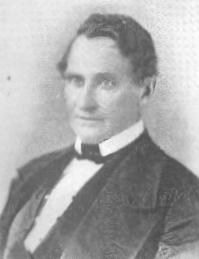 Senator
Oliver Jones spoke for the committee in presentation of the final design "The
committee beg leave to make some remarks of the ground upon which their conclusion is
founded. The President ad interim devised the national flag and seal, as it were, in a
case of emergency, adopting the flag of the United States of America with little
variation, which act was subsequently ratified by the law of December 10, 1836. The then
adopted flag was expedient for the time being, and has been specially beneficial to the
navy and merchantmen on account of being so much blended with the flag of the United
States. But the emergency has passed, and the future prospects of Texas are of such
flattering nature that her independence requires that her arms, seal, and standard should
assume an independent character by a form which will not blend them with those of any
other nation. Besides these considerations, the committee would beg to state that,
inasmuch as the proposition made by this republic in her incipient stage of national
existence to the United States of America for an annexation to the American Confederacy
has been withdrawn by the minister plenipotentiary of this government at the court of
Washington, and as the wish of the majority of the people of Texas, so far as is publicly
known, is in favor of sustaining an independent station among the nations of the earth, we
regard the transition of the single star into the American constellation and the merging
of the single Texan stripe with the thirteen stripes of the United States of America
inexpedient. The committee are convinced of the necessity of adopting a separate and
distinct standard and arms for the republic. . . . Therefore your committee beg leave to
offer a substitute amending the original bill referred to them, accompanying the same with
a specimen of the arms, the seal, and the standard." Senator
Oliver Jones spoke for the committee in presentation of the final design "The
committee beg leave to make some remarks of the ground upon which their conclusion is
founded. The President ad interim devised the national flag and seal, as it were, in a
case of emergency, adopting the flag of the United States of America with little
variation, which act was subsequently ratified by the law of December 10, 1836. The then
adopted flag was expedient for the time being, and has been specially beneficial to the
navy and merchantmen on account of being so much blended with the flag of the United
States. But the emergency has passed, and the future prospects of Texas are of such
flattering nature that her independence requires that her arms, seal, and standard should
assume an independent character by a form which will not blend them with those of any
other nation. Besides these considerations, the committee would beg to state that,
inasmuch as the proposition made by this republic in her incipient stage of national
existence to the United States of America for an annexation to the American Confederacy
has been withdrawn by the minister plenipotentiary of this government at the court of
Washington, and as the wish of the majority of the people of Texas, so far as is publicly
known, is in favor of sustaining an independent station among the nations of the earth, we
regard the transition of the single star into the American constellation and the merging
of the single Texan stripe with the thirteen stripes of the United States of America
inexpedient. The committee are convinced of the necessity of adopting a separate and
distinct standard and arms for the republic. . . . Therefore your committee beg leave to
offer a substitute amending the original bill referred to them, accompanying the same with
a specimen of the arms, the seal, and the standard."
Mrs. Looscan remarks in her article in Wooten's Comprehensive History
of Texas that it was appropriate that the Hon. Oliver Jones introduced the flag of the
independent Republic since he was "one of the noblest patriots and the last
representative of the colonists of Texas in the Mexican Congress prior to opening of
hostilities....." The committee's proposals were approved by President
Mirabeau Lamar, Speaker of the House John Hansford and President of the Senate David
Burnet.
In addition to the Burnet naval
flag and the Burnet second flag of the Republic, the
earliest surviving replica of the contemporary banner is from the Sink's scrapbook of the
1840's. In contrast to the Burnet flags in the same book, the Lone Star was in a field of
bright pure azure with no trace of green. According to Guy M. Bryan in a speech to the
Texas Veterans Association in 1873 the flag was
''a blue perpendicular stripe of the width of one-third of the
whole length of the flag, and a white star of five points in the centre thereof; and two
horizontal stripes of equal length and breadth, the upper stripe of white, the lower red,
of the length of two-thirds of the length of the whole flag."
Huzzah, Huzzah for The Lone
Star!
 The Lone Star flag of today is the composite of
symbols from the individual banners representing the diverse philosophical, cultural,
ethnic and political groups involved in the evolution of Texas to independence and
regional self-determination. Symbolizing the fact that Texas is unique among states of the
world, the composite Lone Star banner is a copy of no one state, yet it employs symbolic
elements of its progenitors. The Lone Star banner employs the red and white colors of its
parent countries Spain, the Mexican
United States of America and the United States of America. Its two wide red and white
stripes symbolize its uniqueness and greatness as a one-time Republic that sets it apart
from any one of the thin original 13 stripes of the USA which was adopted in several
unofficial banners of independence and the Burnet naval flag of the Republic. Absence of Spanish
gold (yellow) distances the banner from the vice-regal tyranny of its parent Spain,
yet its Spanish cultural heritage is maintained in red and white. The removal of eagle,
cactus and snake and the green stripe with rotation of the wide white and red stripes of
the Mexican tri-color from vertical to horizontal distances the
banner from the racism, religious repression and despotism exercised by its Mexican
parent while the width and colors of the two wide horizontal red and white stripes
preserve the state's Mexican heritage which began with liberal revolution and principles
of self-determination. Shining brightest is the single white Lone Star on pure union blue
symbolizing self-reliance, independence, purity of motive and spirit. The Lone Star
symbolizes the uniqueness of the state's independent cultural and political evolution
among the original 13 and the current 50 stars on the banner of the USA. It is the only
state of the USA which joined the union by treaty as an independent republic which had
progressed through the stepwise stuggle for independence, first as a state within and then
an independent republic separate from its parent country Mexico, independence won by the
sacrifice of Texians from diverse ancestry and culture. The single star of Texas,
first displayed on Spanish red in New Spanish Texas by Dr. James
Long and then one of the two gold stars on the banner of the State
of Coahuila y Tejas, was the star of hope for freedom,
democracy and libertarian principles and local self-determination within the Republic of
Mexico which suffered from vice-regal dictatorship, political and cleric corruption and
revolution through most of the 19th century. Symbolic of the unity of the diverse elements
which combined to make it independent, free and great, the Lone Star resides on pure union
blue which evolved from the Burnet naval flag and the De Zavala and Burnet flags of the
Republic and the United States of America. (See also Texian Poetry--The Lone Star) The Lone Star flag of today is the composite of
symbols from the individual banners representing the diverse philosophical, cultural,
ethnic and political groups involved in the evolution of Texas to independence and
regional self-determination. Symbolizing the fact that Texas is unique among states of the
world, the composite Lone Star banner is a copy of no one state, yet it employs symbolic
elements of its progenitors. The Lone Star banner employs the red and white colors of its
parent countries Spain, the Mexican
United States of America and the United States of America. Its two wide red and white
stripes symbolize its uniqueness and greatness as a one-time Republic that sets it apart
from any one of the thin original 13 stripes of the USA which was adopted in several
unofficial banners of independence and the Burnet naval flag of the Republic. Absence of Spanish
gold (yellow) distances the banner from the vice-regal tyranny of its parent Spain,
yet its Spanish cultural heritage is maintained in red and white. The removal of eagle,
cactus and snake and the green stripe with rotation of the wide white and red stripes of
the Mexican tri-color from vertical to horizontal distances the
banner from the racism, religious repression and despotism exercised by its Mexican
parent while the width and colors of the two wide horizontal red and white stripes
preserve the state's Mexican heritage which began with liberal revolution and principles
of self-determination. Shining brightest is the single white Lone Star on pure union blue
symbolizing self-reliance, independence, purity of motive and spirit. The Lone Star
symbolizes the uniqueness of the state's independent cultural and political evolution
among the original 13 and the current 50 stars on the banner of the USA. It is the only
state of the USA which joined the union by treaty as an independent republic which had
progressed through the stepwise stuggle for independence, first as a state within and then
an independent republic separate from its parent country Mexico, independence won by the
sacrifice of Texians from diverse ancestry and culture. The single star of Texas,
first displayed on Spanish red in New Spanish Texas by Dr. James
Long and then one of the two gold stars on the banner of the State
of Coahuila y Tejas, was the star of hope for freedom,
democracy and libertarian principles and local self-determination within the Republic of
Mexico which suffered from vice-regal dictatorship, political and cleric corruption and
revolution through most of the 19th century. Symbolic of the unity of the diverse elements
which combined to make it independent, free and great, the Lone Star resides on pure union
blue which evolved from the Burnet naval flag and the De Zavala and Burnet flags of the
Republic and the United States of America. (See also Texian Poetry--The Lone Star)
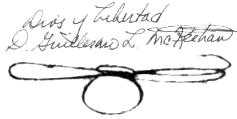
|
SONS OF DEWITT
COLONY TEXAS
© 1997-2012, Wallace L. McKeehan, All Rights Reserved |
 Castile and Leon. Most commonly shown as the flag displayed in
Castile and Leon. Most commonly shown as the flag displayed in 
 The Spanish Flag of 1785 and
its variants may also have been flown in Spanish Texas. The banner and its variants
employed variations of a shield with the symbols of Castile and Leon and other historic
royal alliances topped with a crown in the yellow field of the red-yellow-red tricolor.
The Spanish Flag of 1785 and
its variants may also have been flown in Spanish Texas. The banner and its variants
employed variations of a shield with the symbols of Castile and Leon and other historic
royal alliances topped with a crown in the yellow field of the red-yellow-red tricolor.


 The Mexican tricolor with modifications to symbolize support
of the Federalist system guaranteed by the
The Mexican tricolor with modifications to symbolize support
of the Federalist system guaranteed by the 

 Notice To Ship Masters. The undersigned takes
this method of informing the public that another flagstaff has been erected at the mouth
of the Brazos and as the bar is very often too rough for boats to board vessels, they
might be deceived by seeing both flags flying and in range together therefore the
following signals will be exhibited:
Notice To Ship Masters. The undersigned takes
this method of informing the public that another flagstaff has been erected at the mouth
of the Brazos and as the bar is very often too rough for boats to board vessels, they
might be deceived by seeing both flags flying and in range together therefore the
following signals will be exhibited:  When the vessle is
near down to the Bar the flag on the flagstaff will be hauled down and two smaller flags
erected at a suitable distance from each other these flags will be a black Ball on a white
ground-and are the ranges for crossing the Bar without a Pilot. In running down should it
be to rough for boats to come out you should lay off and on, taking care not to get to the
Westward of the Bar as there is generally a strong current setting in that direction, and
unless your vessel sails well It will be almost impossible to come in. Vessels with good
ground tackle need not be afraid to anchor off the Bar taking care to anchor in 4 1/2
fathoms water in rough weather, and in fine weather they can anchor in safety 3 1/2
fathoms. When vessels are off the Bar in bad weather, a fire will be made on the Beach
every night. I shall still continue to conduct the Pilotage as usual and so do my duty at
the hazard of my life. J. Brown, Pilot. Mouth of Rio Brazos, May 23rd 1835.
When the vessle is
near down to the Bar the flag on the flagstaff will be hauled down and two smaller flags
erected at a suitable distance from each other these flags will be a black Ball on a white
ground-and are the ranges for crossing the Bar without a Pilot. In running down should it
be to rough for boats to come out you should lay off and on, taking care not to get to the
Westward of the Bar as there is generally a strong current setting in that direction, and
unless your vessel sails well It will be almost impossible to come in. Vessels with good
ground tackle need not be afraid to anchor off the Bar taking care to anchor in 4 1/2
fathoms water in rough weather, and in fine weather they can anchor in safety 3 1/2
fathoms. When vessels are off the Bar in bad weather, a fire will be made on the Beach
every night. I shall still continue to conduct the Pilotage as usual and so do my duty at
the hazard of my life. J. Brown, Pilot. Mouth of Rio Brazos, May 23rd 1835. Of the multiple banners that flew over DeWitt
Colony territory and those under which DeWitt colonists served and died, this famous flag
is one which originated solely within and is unique to the DeWitt Colony and a symbol of
contribution of the region to the Texas Independence movement. The banner can be said to
be the counterpart in concept and message of resistance as the early
Of the multiple banners that flew over DeWitt
Colony territory and those under which DeWitt colonists served and died, this famous flag
is one which originated solely within and is unique to the DeWitt Colony and a symbol of
contribution of the region to the Texas Independence movement. The banner can be said to
be the counterpart in concept and message of resistance as the early 

 If blue was the
true color it was probably adapted from the Lone Star on blue of
If blue was the
true color it was probably adapted from the Lone Star on blue of 



 Senator
Oliver Jones spoke for the committee in presentation of the final design "The
committee beg leave to make some remarks of the ground upon which their conclusion is
founded. The President ad interim devised the national flag and seal, as it were, in a
case of emergency, adopting the flag of the United States of America with little
variation, which act was subsequently ratified by the law of December 10, 1836. The then
adopted flag was expedient for the time being, and has been specially beneficial to the
navy and merchantmen on account of being so much blended with the flag of the United
States. But the emergency has passed, and the future prospects of Texas are of such
flattering nature that her independence requires that her arms, seal, and standard should
assume an independent character by a form which will not blend them with those of any
other nation. Besides these considerations, the committee would beg to state that,
inasmuch as the proposition made by this republic in her incipient stage of national
existence to the United States of America for an annexation to the American Confederacy
has been withdrawn by the minister plenipotentiary of this government at the court of
Washington, and as the wish of the majority of the people of Texas, so far as is publicly
known, is in favor of sustaining an independent station among the nations of the earth, we
regard the transition of the single star into the American constellation and the merging
of the single Texan stripe with the thirteen stripes of the United States of America
inexpedient. The committee are convinced of the necessity of adopting a separate and
distinct standard and arms for the republic. . . . Therefore your committee beg leave to
offer a substitute amending the original bill referred to them, accompanying the same with
a specimen of the arms, the seal, and the standard."
Senator
Oliver Jones spoke for the committee in presentation of the final design "The
committee beg leave to make some remarks of the ground upon which their conclusion is
founded. The President ad interim devised the national flag and seal, as it were, in a
case of emergency, adopting the flag of the United States of America with little
variation, which act was subsequently ratified by the law of December 10, 1836. The then
adopted flag was expedient for the time being, and has been specially beneficial to the
navy and merchantmen on account of being so much blended with the flag of the United
States. But the emergency has passed, and the future prospects of Texas are of such
flattering nature that her independence requires that her arms, seal, and standard should
assume an independent character by a form which will not blend them with those of any
other nation. Besides these considerations, the committee would beg to state that,
inasmuch as the proposition made by this republic in her incipient stage of national
existence to the United States of America for an annexation to the American Confederacy
has been withdrawn by the minister plenipotentiary of this government at the court of
Washington, and as the wish of the majority of the people of Texas, so far as is publicly
known, is in favor of sustaining an independent station among the nations of the earth, we
regard the transition of the single star into the American constellation and the merging
of the single Texan stripe with the thirteen stripes of the United States of America
inexpedient. The committee are convinced of the necessity of adopting a separate and
distinct standard and arms for the republic. . . . Therefore your committee beg leave to
offer a substitute amending the original bill referred to them, accompanying the same with
a specimen of the arms, the seal, and the standard." 